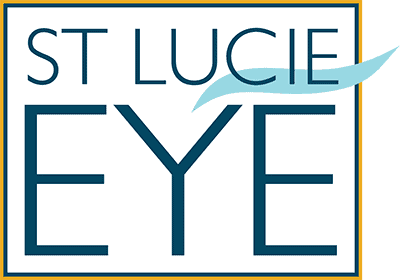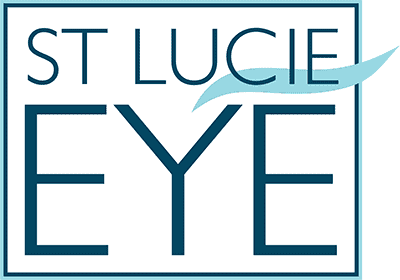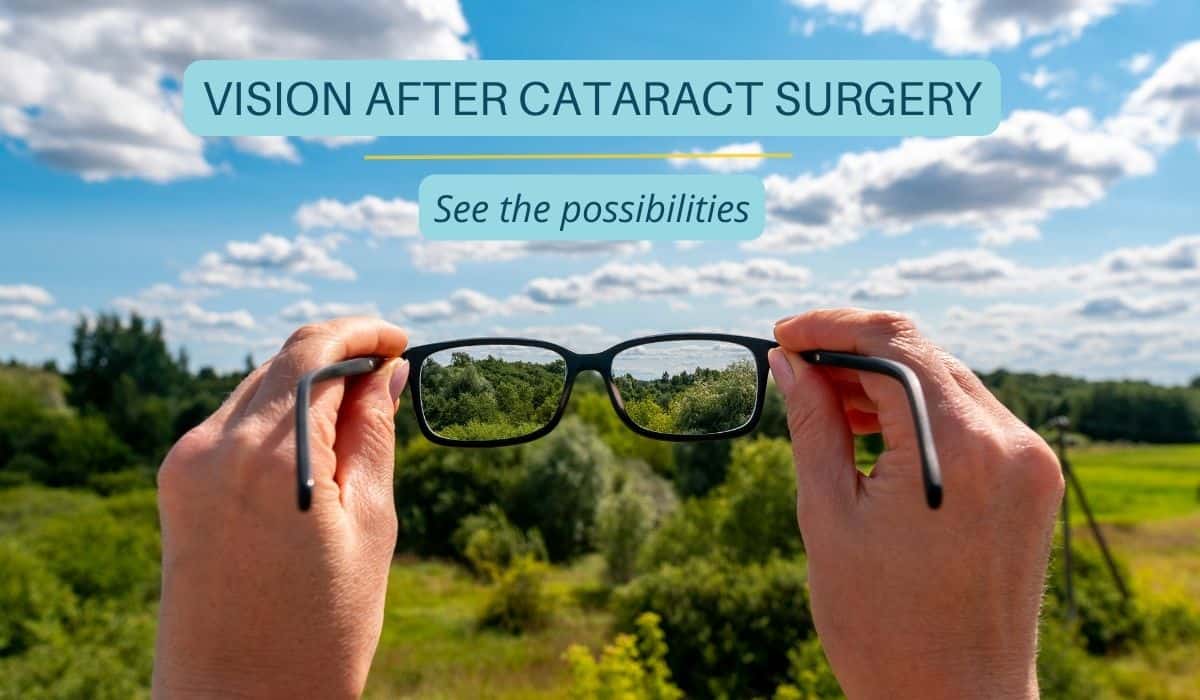Cataract Surgery is an Opportunity to Change Vision
You’ve just been told you need cataract surgery, and now you might be wondering about the vision outcomes after the procedure. Cataract surgery presents a unique opportunity to enhance your vision and potentially reduce your reliance on glasses. In this article, we’ll explore the various options available for vision correction during cataract surgery and what you can expect from the procedure.
Understanding Cataracts and Their Impact on Vision
1. What is a Cataract?
A cataract is a clouding and deterioration of the natural lens inside the eye that typically occurs due to aging.
2. What is Natural, Normal Vision?
Natural vision has three distinct zones; NEAR, INTERMEDIATE, DISTANCE.
When eyesight is normal, it progresses smoothly through each zone allowing for seamless vision without glasses. Eyeglasses and contacts attempt to replicate this seamless experience when eyes develop refractive errors such as farsightedness, nearsightedness or astigmatism.
- NEAR allows for details that are 2 feet or closer to the viewer. Hobbies like sewing, craft work, artwork, and activities that require close eye-hand coordination are all near focused. Many daily functions such as using your phone, reading labels, preparing food, eating and personal care and hygiene are also considered near activities.
- INTERMEDIATE vision is typically a distance of 20-40 inches, or arm’s length. This distance is the most common when viewing computer monitors and car dashboards. Intermediate distance is also used for reading retail store labels and easily scanning grocery store shelves.
- DISTANCE vision is the standard most people consider for cataract surgery because it supports visual orientation to the environment. Driving and the ability to read road signs are critical to maintain independence and mobility. Entertainment and physical activities are considered in this distance as well: watching TV, movies, golfing, tennis, walking, running, bird watching, and pickleball all rely on good distance vision.
3. How Cataracts Affect Vision
When eyes are young and healthy, the natural lens is translucent and flexible and is able to focus across multiple distances for a seamless visual experience.
With age, the natural lens thickens and forms a cloudy cataract. Vision gradually deteriorates as light starts to scatter irregularly through the cataract on its way back to the eye’s focal point.
Visual symptoms continue to grow worse over time as the cataract matures, yellows, and thickens.
You can expect any or all of the following visual symptoms as cataracts develop.
- Blurred images and reduced clarity especially at distance.
- Decreased depth and color perception.
- Sensitivity to light and glare.
- Trouble seeing at night or in low light situations.
- Appearance of halos around lights
Improving Multiple Vision Issues with Cataract Surgery
Multiple conditions that impair vision can occur together – especially after age sixty.
The good news is that several of these problems can be treated at the same time with cataract surgery.
- Astigmatism refers to an abnormally shaped cornea where light doesn’t focus properly resulting in blurry vision. Glasses, contacts, laser surgery or a Toric replacement lens during cataract surgery can correct astigmatism.
- Presbyopia is literally translated as ‘old-man vision’. Around age 40, the natural lens of the eye loses its elasticity and cannot change focal point to see things clearly up-close. Presbyopia can be corrected with glasses or a specialty replacement lens during cataract surgery.
- Cataracts occur as the eye ages, or more rarely through blunt trauma or certain medication use. Cataracts affect the clarity of vision overall and greatly impact the distance vision used for driving, watching TV, and outdoor activities. Cataracts grow worse over time and can only be corrected with a replacement lens during surgery.
Choosing the Right Cataract Replacement Lens
Cataract surgery successfully removes a clouded, aging lens and replaces it with a clear artificial lens with refractive powers. The intraocular lens (IOL) can improve several visual problems – in addition to removing the cloudy cataract.
- farsightedness
- astigmatism
- presbyopia
-
nearsightedness
For many patients, the choice of cataract replacement lens is not a big deal. They simply want the basic lens covered by their insurance and don’t mind wearing glasses after cataract surgery. Patients who have worn glasses most of their lives frequently say they would feel naked or lost without them.
However, many patients look forward to finally being free of glasses, especially when participating in social activities, hobbies, and sports.
The type of cataract replacement lens you choose will affect your need for, and dependence on, prescription eyeglasses after the procedure.
If you currently wear glasses to see your best – whether just for reading, driving, or for most everyday activities – there is a cataract replacement lens that can accomplish similar results and reduce the need for glasses.
The choice of replacement lens (IOL) will depend on patient preference, budget, and any pre-existing eye condition that could affect visual outcome after the surgery.
1. Monofocal Lenses: The most popular choice for cataract patients, monofocal lenses are designed to provide good to excellent correction for one distance – either near or far. Monofocals are the standard replacement lens covered by insurance. They can also be used for blended vision (see below).
2. Toric Lenses: Astigmatism is quite common and occurs when the eye surface is irregularly shaped like a football instead of perfectly round. About one in three people have astigmatism. Toric IOLs correct the aberrations of astigmatism and provide excellent vision for one distance similar to monofocals. There are out-of-pocket costs for Toric lenses which may also require laser assistance for accurate placement during cataract surgery.
3. Multi-focal or Trifocal Lenses: These specialty lenses provide clear vision across multi distances and are the best selection to be glasses free in most situations. Patients can expect to enjoy most daily activities such as reading a book, ordering from a menu, seeing clearly in the mirror, watching TV, or driving during the day without eyeglasses. Some detailed tasks can be improved by wearing glasses, which is common with any lens. Because these lenses split light into three zones, some patients will experience halos around lights, especially at night. These specialty lenses are not covered by insurance and may require laser assistance for accurate placement during cataract surgery.
4. Extended Depth of Focus Lenses: EDOF lens create a single elongated focal point to enhance the range of focus for near and distance vision, rather than splitting into three distinct zones as in trifocal lenses. EDOFs are an excellent choice for patients seeking relief from wearing glasses for most activities with very few side effects. Reading glasses are usually still needed for fine print and detailed close tasks. These lenses may have additional laser assisted costs and are not covered under insurance.
5. Blended Vision: Also referred to as monovision, blended vision is accomplished when your surgeon selects different IOL powers for each eye, typically setting the dominant eye for distance vision and the non-dominant eye for near. After surgery, the brain adapts to the different focal lengths and blends together. The eye set for distance becomes dominant for far-off objects, while the eye set for near vision becomes dominant for close-up tasks. Most patients reduce their dependence on glasses for activities like reading, using a smartphone, or performing tasks at arm’s length. However, monovision may not provide perfect vision for all tasks and may not be suitable for everyone. Monovision can be tested before cataract surgery using contact lenses.
Understanding the Cost of Specialty Replacement Lenses
When cataracts affect daily life, cataract surgery is required to improve vision. Health Insurance and Medicare cover the fees for cataract surgery, including the standard monofocal replacement lens.
Specialty lenses to correct other visual issues such as astigmatism, presbyopia, or for multiple distance vision are additional out-of-pocket expenses that can vary from $1500-$5000 per eye depending on the specific lens and if the procedure requires laser assistance.
However, these upfront costs can be comparable to purchasing progressive eyeglasses, readers and prescription sunglasses over time – especially when updated frequently for style or wear.
Out-of-pocket expenses for specialty lenses can be paid with cash or with credit card or through healthcare financing companies like Care Credit.
Improvements You Can Expect After Cataract Surgery
Because cataracts slowly diminish vision over time, patients are initially amazed at how bright colors appear after surgery and how vibrant everything looks.
“I thought my favorite blouse was brown, when it actually was purple!”, remarked one incredulous post-op patient. “I must have been wearing some interesting color ensembles before my cataract surgery’, she joked.
Another patient was amazed at the colors of the golf course and that he could now track the golf ball across a bright blue sky. “The change is absolutely incredible! I had no idea my vision had changed that much. I’m blaming all of my bad golf scores on cataracts.”
If you choose to improve presbyopia or astigmatism with cataract surgery, you can expect your vision to improve to the point where you only need glasses in specific situations or not at all.
Dr. Kenneth Langley, now a retired ophthalmologist, was also shocked at the change. An active golfer, fisherman and skier, Dr. Langley is now glasses free after cataract surgery with Dr. Rana at St Lucie Eye.
“Almost every day I find something new that I can do now without glasses that I couldn’t do before. Basically, all of my glasses now are living in a box. The only thing I need are sunglasses when I’m outdoors – and I don’t need them with prescription lenses!”
Consult with Your Eye Doctor for the Best Cataract Surgery Options.
St Lucie Eye physicians have successfully partnered with cataract patients for over 60 years.
Continued technological advances have made the procedure even more accurate and effective over time. Today’s cataract surgery is the most common – and safest! – operation performed in the US with over 3.7 million successful procedures per year.
But we understand that the thought of cataract surgery can be intimidating, or scary, for most patients. We’re here to help.
Your St Lucie Eye surgeon will discuss your surgery in detail to eliminate any anxiety. After a detailed comprehensive exam and measurements, they will review the benefits and potential side effects based on your visual preferences and expectations after surgery.
Ready to see how much better life can look after cataract surgery?
Start by answering this pre-cataract surgery visual preference questionnaire, then discuss your answers with your physician.
Need more information? Contact us for an appointment or questions about your insurance.


